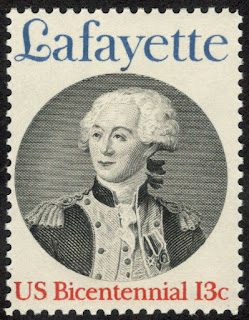Lafayette was born into a wealthy land-owning family in Chavaniac in the province of Auvergne in south central France. He followed the family's martial tradition and was commissioned an officer at age 13. He became convinced that the American revolutionary cause was noble, and he traveled to the New World seeking glory in it. He was made a major general at age 19, but he was initially not given American troops to command. He was wounded during the Battle of Brandywine but still managed to organize an orderly retreat, and he served with distinction in the Battle of Rhode Island. In the middle of the war, he sailed for home to lobby for an increase in French support. He returned to America in 1780 and was given senior positions in the Continental Army. In 1781, troops under his command in Virginia blocked forces led by Cornwallis until other American and French forces could position themselves for the decisive Siege of Yorktown.
Lafayette returned to France and was appointed to the Assembly of Notables in 1787, convened in response to the fiscal crisis. He was elected a member of the Estates General of 1789, where representatives met from the three traditional orders of French society: the clergy, the nobility, and the commoners. After forming the National Constituent Assembly, he helped to write the Declaration of the Rights of Man and of the Citizen with Thomas Jefferson's assistance. This document was inspired by the United States Declaration of Independence and invoked natural law to establish basic principles of the democratic nation-state. He also advocated the end of slavery, in keeping with the philosophy of natural liberty. After the storming of the Bastille, he was appointed commander-in-chief of France's National Guard and tried to steer a middle course through the years of revolution. In August 1792, radical factions ordered his arrest, and he fled into the Austrian Netherlands. He was captured by Austrian troops and spent more than five years in prison.
Lafayette returned to France after Napoleon Bonaparte secured his release in 1797, though he refused to participate in Napoleon's government. After the Bourbon Restoration of 1814, he became a liberal member of the Chamber of Deputies, a position which he held for most of the remainder of his life. In 1824, President James Monroe invited him to the United States as the nation's guest, and he visited all 24 states in the union and met a rapturous reception. During France's July Revolution of 1830, he declined an offer to become the French dictator. Instead, he supported Louis-Philippe as king, but turned against him when the monarch became autocratic. He died on 20 May 1834 and is buried in Picpus Cemetery in Paris, under soil from Bunker Hill. He is sometimes known as "The Hero of the Two Worlds" for his accomplishments in the service of both France and the United States.
US stamp and First Day Cover depicting Lafayette
Ivan Meštrović (15 August 1883 – 16 January 1962) was a renowned Yugoslavian and Croatian sculptor, architect and writer of the 20th century.
He was the most prominent sculptor of Croatian modern sculpture and a leading personality of artistic life in Zagreb. He studied at the Pavle Bilinić's Stone Workshop in Split and at the Academy of Fine Arts Vienna, where he was formed under the influence of the Secession. He traveled throughout Europe and studied the works of ancient and Renaissance masters, especially Michelangelo, and French sculptors A. Rodin, A. Bourdelle and A. Maillola. He was the initiator of the national-romantic group Medulić (he advocated the creation of art of national features inspired by the heroic folk songs). During the First World War, he lived in emigration. After the war, he returned to Croatia and began a long and fruitful period of sculpture and pedagogical work. In 1942 he emigrated to Italy, in 1943 to Switzerland and in 1947 to the United States. He was a professor of sculpture at the Syracuse University and from 1955 at the University of Notre Dame in South Bend, Indiana.
Most of his early works of symbolic themes were formed in the spirit of the Secession, some of which, like the Well of Life, show impressionist restless surfaces created under the influence of Rodin's naturalism, and the second, reviving national myth, become stylized monumental plastics (Kosovo cycle, 1908-1910). Before the First World War, he left pathetic epic stylization, expressing increasingly emotional states, as evidenced by the wooden reliefs of biblical themes made in a combination of Archaic, Gothic, Secessionist and Expressionist styles. During the 1920s and 1930s, the classical component prevailed in his works. In this period, he created a number of public monuments of strong plastic expression, pronounced and legible shapes (Grgur Ninski and Marko Marulić in Split, Andrija Medulić, Andrija Kačić-Miošić and Josip Juraj Strossmayer in Zagreb, The Bowman and The Spearman in Chicago). Portraits take a special place in his opus.
Meštrović achieved works of strong plastic value in the construction-sculptural monuments and projects, mostly with central layout (the Mausoleum of the Račić family in Cavtat, the Mausoleum of the Meštrović family in Otavice, the Meštrović Pavilion in Zagreb, Monument to the Unknown Hero in Belgrade). He also designed a memorial church of King Zvonimir in Biskupija near Knin inspired by old Croatian churches, a representative family palace, today the Ivan Meštrović Gallery, and reconstructed renaissance fortified mansion Crikvine-Kaštilac in Split.






No comments:
Post a Comment